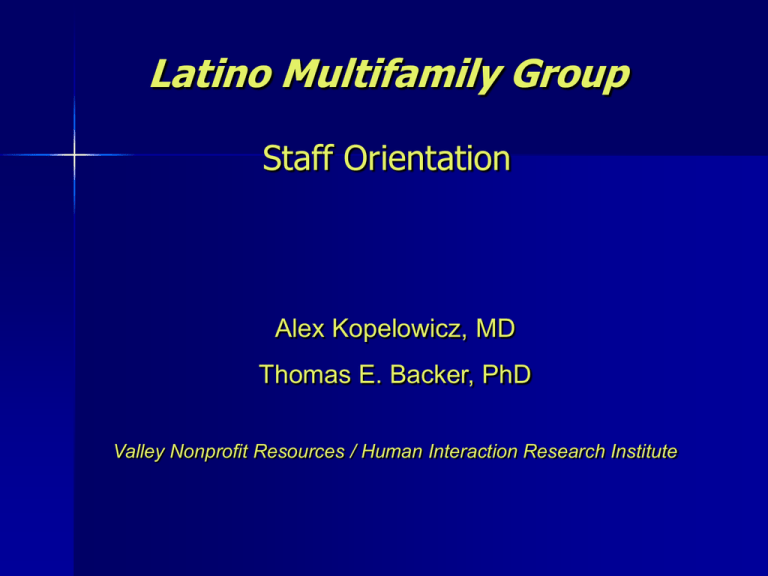Staff Introduction (.ppt)
advertisement

Latino Multifamily Group Staff Orientation Alex Kopelowicz, MD Thomas E. Backer, PhD Valley Nonprofit Resources / Human Interaction Research Institute Presentation Outline A. What is MFG and why should we do it? B. Components of MFG C. Adapting MFG for Latinos D. Preliminary findings of RCT focused on MFG for Mexican-Americans E. Disseminating the MFG Components of the Latino MFG Family psychoeducation Communication skills training Problem solving techniques Social network development PORT (2004) Treatment Recommendations Patients who have on-going contact with their families should be offered a family psychosocial intervention which spans at least nine months and which provides a combination of education about the illness, family support, crisis intervention, and problem solving skills training. Such interventions should also be offered to non-family caregivers. Better outcomes in family psychoeducation Over 20 controlled clinical trials, comparing to standard outpatient treatment, have shown: – Much lower relapse rates and rehospitalization Up to 75% reductions of rates; minimally 50% – Increased employment At least twice the number of consumers employed, and up to four times greater--over 50% employed after two years--when combined with supported employment – Improved family relationships and well-being – Reduced friction and family burden – Reduced medical illness in family members Doctor visits for family members decreased by over 50% in one year McFarlane et al 2003 MFG Reduces Re-hospitalization Rates 1 0.95 0.9 MFG SC 0.85 0.8 0.75 Months (Dyck et al, 2001) 11 9 7 5 3 1 0.7 1-Year Survival Rates Among Bipolar Patients in Family-Focused Treatment versus Case Management Cumulative Survival Rate 1 FFT, N=31 0.8 0.6 0.4 CM, N=70 0.2 0 0 5 10 Pretreatment 15 20 25 30 35 Treatment 40 45 50 55 Follow-up Wilcoxon Test, c2 (1)=3.99, P =.046 Miklowitz DJ, et al. Biol Psychiatry, 2000;48(6):582-592 Remission to 2 years MFG SFT % in remission 100 90 80 70 60 50 0 100 200 300 400 500 600 700 Days at risk N: PEMFG=83; PESFT=92 Main effect: p=.05 McFarlane et al, 2003 800 Dosages in MFG and SFT Chlorpromazine equivalents in mgs. 1000 900 875 850 800 751 700 656 600 500 400 -5 McFarlane et al, 2003 0 5 10 15 Months MFG SFT 20 25 30 Stages of a Psychoeducational Multifamily Group Joining Family and client separately 3-6 weeks Educational workshop Families only 1 day Ongoing MFG Families & clients bi-weekly 6-9 months MULTIFAMILY GROUPS Five to Eight Families Two Facilitators 1 ½-Hour Sessions – Biweekly – 6-9 months Refreshments/snacks provided Initial sessions avoid emphasis on clinical issues Initial sessions emphasize establishing a working alliance by building group identity and developing a sense of mutual interest and concern. Drop outs are failures JOINING with FAMILIES & CLIENTS JOINING means to CONNECT, BUILD RAPPORT, CONVEY EMPATHY, ESTABLISH AN ALLIANCE, ENGAGE It is the first stage of treatment Designed to create a bond between client/family members and facilitators FACILITATOR as ADVOCATE PROBLEM SOLVING IN MFGs The CORE of MFG sessions Designed to compensate information-processing deficits in mental disorders FORMAT: Checking in 15 Minutes Go-round 20 Minutes Selecting a Problem to Solve 5 Minutes Solving the Problem 45 Minutes Wrap-up Socializing 5 Minutes Facilitators should GET READY and HAVE A PLAN – IN ADVANCE THE PROBLEM-SOLVING METHOD 1. 2. 3. 4. 5. 6. Define the Problem or Goal List Possible Solutions Evaluate Advantages and Disadvantages of each Solution Choose “The Best” Solution Implement Plan to Carry Out Solution Review Implementation and Outcome The Assessment of Culture Best undertaken by paying attention to people’s daily routines and how such activities are tied to families, social networks and communities The key to a cultural assessment is asking what matters most to people or what is most at stake for people The cultural question is: What are the factors in a particular culture that need to be considered prior to implementing multifamily group psychoeducation developed with a Euro-American population of people with mental disorders? Cultural Modifications for Latinos Encourage participation of fathers Acknowledge folk conceptions of illness Reframe to fit family beliefs and attitudes Focus on education rather than strictly on communication/problem solving skills Acknowledge each family member’s role Goal: Interdependence vs independence Utilize prosocial factors (e.g., warmth) Efficacy of MFG – RCT Study Results T ime T o H o s p italiz atio n 100% 174 MexicanAmerican subjects 1 year of treatment 1 year of follow-up Overall log-rank Χ2=13.3, df=2, p=.001. Kopelowicz et al, under review % Not Rehospitalized 90% 80% 70% 60% 50% 40% 30% A 20% S 10% C 0% 0 1-4 5-8 9-12 13-18 Mo n th s A fte r B a se lin e 19-24 Disseminating the MFG Approach Raising the Bar project – Training program and technical assistance to implement MFG for adults with mental illness – Resulted in a number of program adoptions in the San Fernando Valley region of Los Angeles Latino MFG project – Training program and technical assistance to implement Spanish-language MFG for families of adolescents – Resulted in six pilot adoptions so far, four of them evaluated with positive results (national dissemination now underway) For more information, go to www.valleynonprofitresources.org, Resources section

